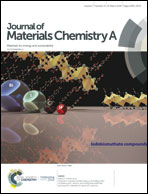Jahn–Teller type small polaron assisted Na diffusion in NaMnO2 as a cathode material for Na-ion batteries†
Abstract
Na-ion diffusion kinetics is one of the main bottlenecks that limit the charge/discharge rate of the electrode materials in Na-ion batteries. In this paper, we identified that Na-ion diffusion is assisted by the Jahn–Teller (JT) type small polaron in the NaMnO2 compound from density functional theory calculations. The structure of NaMnO2 is modeled using two extreme cases of JT distorted structures, namely z-direction elongated E-NaMnO2 and compressed C-NaMnO2, both of which may occur in the structure of NaMnO2 at environmental temperatures. The performance of the NaMnO2 cathode material is evaluated. The average charge/discharge potentials are calculated to be 3.00 and 2.91 V for E-NaMnO2 and C-NaMnO2, respectively. The band gaps of E-NaMnO2 and C-NaMnO2 are 1.04 and 0.15 eV, indicating that the NaMnO2 material composed of both E-NaMnO2 and C-NaMnO2 components is a small gap semiconductor. Ultra-low Na-ion migration energy barriers are observed. The lowest energy barriers for dilute Na-ion/vacancy diffusion in the fully charged/discharged state Na0MnO2/NaMnO2 are found to be 0.29 and 0.36 eV, respectively. Interestingly, a strong coupling effect between Na-ions and JT-type polarons has been found in NaMnO2. The low Na-vacancy migration energy barrier is a result of the collaborative migration of the JT-type polarons and the Na-vacancies. Considering the good stability, suitable extraction potential, excellent electronic conductivity, and outstanding ionic transport, NaMnO2 is shown to have potential applications as a cathode material for Na-ion batteries.



 Please wait while we load your content...
Please wait while we load your content...